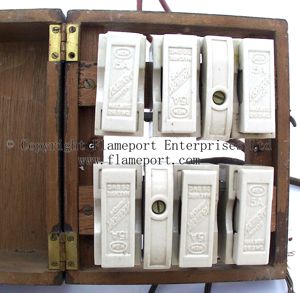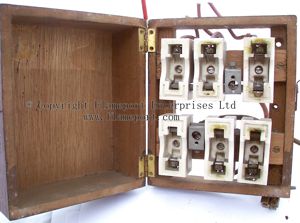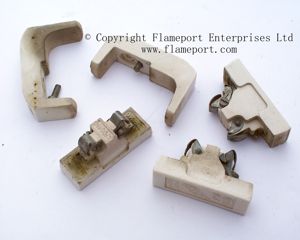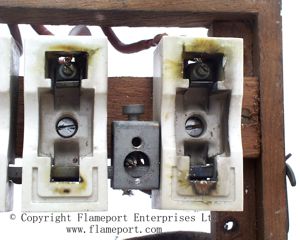Varnished wooden case with two rows of 3 fuses.
This item was removed from a property in August 2010. It is at least 60 years old.
External view
 This is how the fusebox would look when installed. The outer frame and cover is varnished wood. The back is completely open.
This is how the fusebox would look when installed. The outer frame and cover is varnished wood. The back is completely open.
There are 6 fuses, 3 on each level. There are only 3 circuits, as both the live and neutral are fused.
The two ceramic items with a fixing screw are covers for the live and neutral incoming supply.
Cover open, fuses removed

 Here the open front cover can be seen, and the fuses have been removed.
Here the open front cover can be seen, and the fuses have been removed.
Note the yellow colour on most of the ceramic parts - this is damage caused by overheating.
The neutral wire is still connected to the lower set of fuses. This is rubber insulated with a cotton cover.
Fuse bases

 The first image shows two of the fuse bases, with the incoming live connection between them. Outgoing circuits connected to the top terminal of each fuse.
The first image shows two of the fuse bases, with the incoming live connection between them. Outgoing circuits connected to the top terminal of each fuse.
These have suffered from significant overheating which has caused the yellow/brown marks. The blackening on the right side base is burning where the fuse has blown many times.
The remains of the red (live) rubber insulated wiring can be seen behind the fuse bases. Similar black wiring connected to the lower set of fuses (neutral). Earth wires connected to a separate terminal outside of the box.
Fuses and terminal covers
The second image shows three rewireable fuses and two ceramic terminal covers. As with the bases, these fuses are signifciantly damaged by overheating and previously blown fusewire.
Most of these have no fusewire, as two of the three circuits connected to this fusebox were completely ruined and unsafe. The ancient rubber insulated wire had crumbled and shorted together in many places.
This fusebox originally supplied three socket outlets. Two were unusable due to wiring faults and had clearly been like this for many years. The remaining circuit was rubber cabling from the 1950s with a slightly more recent (1970s) 13A socket outlet on the end.
DANGER If you have anything like this in your home, it isn't due for replacement now - it should have been replaced at least 30 years ago. Installations like this are decades past their expected lifespan and are a serious fire hazard.


